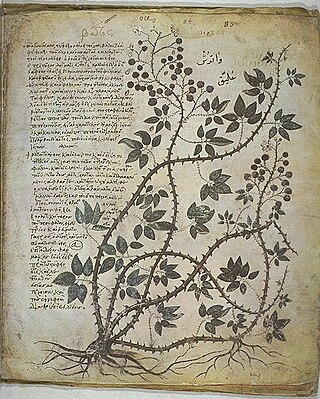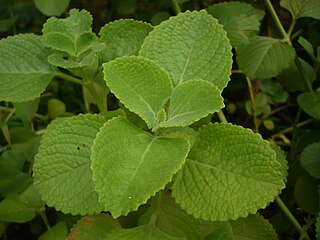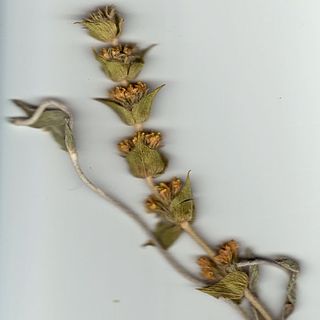
Salvia rosmarinus, commonly known as rosemary, is a shrub with fragrant, evergreen, needle-like leaves and white, pink, purple, or blue flowers. It is native to the Mediterranean region, as well as Portugal and Spain. Until 2017, it was known by the scientific name Rosmarinus officinalis, now a synonym.

Materia medica is a Latin term from the history of pharmacy for the body of collected knowledge about the therapeutic properties of any substance used for healing. The term derives from the title of a work by the Ancient Greek physician Pedanius Dioscorides in the 1st century AD, De materia medica, 'On medical material'.

Apocynaceae is a family of flowering plants that includes trees, shrubs, herbs, stem succulents, and vines, commonly known as the dogbane family, because some taxa were used as dog poison. Members of the family are native to the European, Asian, African, Australian, and American tropics or subtropics, with some temperate members. The former family Asclepiadaceae is considered a subfamily of Apocynaceae and contains 348 genera. A list of Apocynaceae genera may be found here.

Oenanthe, known as water dropworts, oenanthes, water parsleys, and water celeries, are a genus of plants in the family Apiaceae. Most of the species grow in damp ground, such as in marshes or in water.

Coleus amboinicus, synonym Plectranthus amboinicus, is a semi-succulent perennial plant in the family Lamiaceae with a pungent oregano-like flavor and odor. Coleus amboinicus is considered to be native to parts of Africa, the Arabian Peninsula, and India, although it is widely cultivated and naturalized elsewhere in the tropics where it is used as a spice and ornamental plant. Common names in English include Indian borage, country borage, French thyme, Indian mint, Mexican mint, Cuban oregano, broad leaf thyme, soup mint, Spanish thyme. The species epithet, amboinicus refers to Ambon Island, in Indonesia, where it was apparently encountered and described by João de Loureiro (1717–1791).

Apocynum, commonly known as dogbane or Indian hemp, is a small genus of the flowering plant family Apocynaceae. Its name comes from Ancient Greek ἀπόκυνονapókunon, from ἀπο-apo- "away" and κύωνkúōn "dog", referring to dogbane, which was used to poison dogs. The genus is native to North America, temperate Asia, and southeastern Europe.

Nerium oleander, commonly known as oleander or rosebay, is a shrub or small tree cultivated worldwide in temperate and subtropical areas as an ornamental and landscaping plant. It is the only species currently classified in the genus Nerium, belonging to subfamily Apocynoideae of the dogbane family Apocynaceae. It is so widely cultivated that no precise region of origin has been identified, though it is usually associated with the Mediterranean Basin.

Apocynum cannabinum is a perennial herbaceous plant that grows throughout much of North America—in the southern half of Canada and throughout the United States. It is poisonous to humans, dogs, cats, and horses. All parts of the plant are toxic and can cause cardiac arrest if ingested. Some Lepidoptera feed on this plant, such as the hummingbird moth.

Pietro Andrea Gregorio Mattioli was a doctor and naturalist born in Siena. His most important work was a commentary on the medicinal plants of Pedanius Dioscorides first published in 1544 which was translated into several languages and went into thirteen editions in his lifetime.

Sideritis, also known as ironwort, mountain tea, Greek tea and shepherd's tea, is a genus of flowering plants known for their use as herbal medicine, commonly as a herbal tea. They are abundant in Mediterranean regions, the Balkans, the Iberian Peninsula and Macaronesia, but can also be found in Central Europe and temperate Asia.

An animal repellent consists of any object or method made with the intention of keeping animals away from personal items as well as food, plants or yourself. Plants and other living organisms naturally possess a special ability to emit chemicals known as semiochemicals as a way to defend themselves from predators. Humans purposely make use of some of those and create a way to repel animals through various forms of protection.

The Naples Dioscurides, in the Biblioteca Nazionale, Naples, is an early 7th-century secular illuminated manuscript Greek herbal. The book has 172 folios and a page size of 29.7 x 14 cm and the text is a redaction of De Materia Medica by the 1st century Greek military physician Dioscorides, with descriptions of plants and their medicinal uses. Unlike De Materia Medica, the text is arranged alphabetically by plant.

Apocynum androsaemifolium, the fly-trap dogbane or spreading dogbane, is a flowering plant in the Gentianales order. It is common across Canada and much of the United States excepting the deep southeast.

Staphisagria macrosperma, formerly known as Delphinium staphisagria, is a species of Staphisagria of the family Ranunculaceae. It used to belong to the subgenus or section Staphisagria of the genus Delphinium, but molecular evidence suggests Staphisagria should be a genus which is a sister group to the Aconitum-Delphinium clade. It is described botanically as a stoutly-stemmed, hairy biennial with large palmate leaves up to 6 inches (15 cm) across. The flowers are mauve-blue to blue, short-spurred, and up to 1 inch (2.5 cm) across, occurring in racemes. The plant grows to a height of 4–5 feet. It grows throughout the Mediterranean. All parts of this plant are highly toxic and should not be ingested in any quantity.

The term bane, in botany, is an archaic element in the common names of plants known to be toxic or poisonous.

Vincetoxicum hirundinaria, commonly named white swallow-wort, is a long-lived herbaceous perennial of the genus Vincetoxicum in the family Apocynaceae.

Chrysochus auratus, more commonly known as the dogbane beetle, is a leaf beetle primarily found in the eastern United States. The beetle is approximately 8 to 11 mm in length, and possesses an oblong and convex shape. This beetle has two pairs of wings, one of which is a pair of copper colored elytra. The beetle is typically found to have a blue-green hue, and its color is often used to ward away potential predators.

De materia medica is a pharmacopoeia of medicinal plants and the medicines that can be obtained from them. The five-volume work was written between 50 and 70 CE by Pedanius Dioscorides, a Greek physician in the Roman army. It was widely read for more than 1,500 years until supplanted by revised herbals in the Renaissance, making it one of the longest-lasting of all natural history and pharmacology books.

Opopanax is a genus of plants in the family Apiaceae.

Coleus neochilus, synonym Plectranthus neochilus, which is colloquially known as lobster bush, fly bush or mosquito bush, is a perennial ground cover with highly fragrant, partially scalloped, ovate leaves and purple blue inflorescent spikes.





















